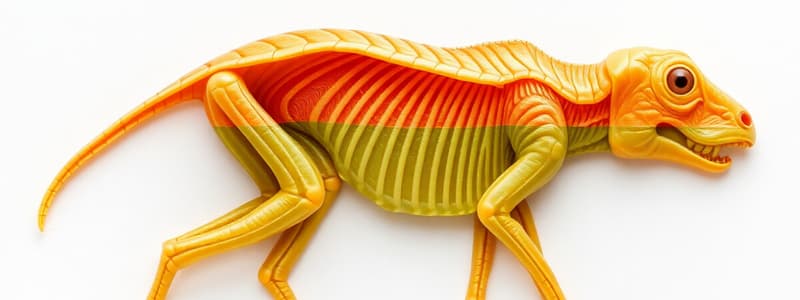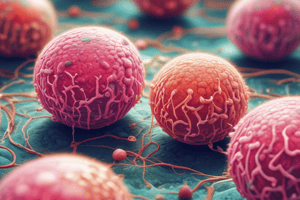Podcast
Questions and Answers
What is one of the main advantages of the amniotic egg?
What is one of the main advantages of the amniotic egg?
- Ability to swim
- Increased access to terrestrial environments (correct)
- Increase in body size
- Lower metabolic rates
Which group of animals is characterized by the presence of mammary glands and hair?
Which group of animals is characterized by the presence of mammary glands and hair?
- Reptiles
- Amphibians
- Mammals (correct)
- Birds
What is a key characteristic of ectotherms?
What is a key characteristic of ectotherms?
- Body heat comes primarily from the environment (correct)
- Generate their own body heat
- Depend on metabolic processes for heat
- Maintain constant internal body temperature
Which of the following is NOT a group included under the class of reptiles?
Which of the following is NOT a group included under the class of reptiles?
What reproduction method involves the embryo developing in an egg sac attached to the mother?
What reproduction method involves the embryo developing in an egg sac attached to the mother?
Which of these accurately describes monotremes?
Which of these accurately describes monotremes?
What is the primary distinguishing factor among the three major lineages of mammals?
What is the primary distinguishing factor among the three major lineages of mammals?
Which group includes tuataras?
Which group includes tuataras?
What is the primary distinction between coelomates and acoelomates?
What is the primary distinction between coelomates and acoelomates?
Which characteristic is NOT associated with the phylum Cnidaria?
Which characteristic is NOT associated with the phylum Cnidaria?
Which of the following statements correctly describes amphibians?
Which of the following statements correctly describes amphibians?
What defines a protostome during the early stages of development?
What defines a protostome during the early stages of development?
Which class of Mollusca is characterized by a complete digestive system and bilateral symmetry?
Which class of Mollusca is characterized by a complete digestive system and bilateral symmetry?
Which characteristic is true for all members of Phylum Echinodermata during adulthood?
Which characteristic is true for all members of Phylum Echinodermata during adulthood?
What is a defining feature of the Chordata phylum?
What is a defining feature of the Chordata phylum?
Which of the following statements is false about roundworms (Nematoda)?
Which of the following statements is false about roundworms (Nematoda)?
What type of symmetry is primarily exhibited by cnidarians?
What type of symmetry is primarily exhibited by cnidarians?
Which group of animals is referred to as 'jawless fish'?
Which group of animals is referred to as 'jawless fish'?
Study Notes
Diploblastic vs. Triploblastic
- Diploblastic organisms have two primary germ layers: ectoderm and endoderm
- Triploblastic organisms have three primary germ layers: ectoderm, endoderm, and mesoderm
Body Plans of Animals
- Asymmetrical animals lack any symmetry
- Radially symmetrical animals have body parts arranged around a central axis
- Bilaterally symmetrical animals have a distinct left and right side
Acoelomates vs. Coelomates
- Coelom refers to a body cavity derived from mesoderm tissue
- Acoelomates are triploblastic animals without a coelom, with mesoderm filled with tissue
- Coelomates (also known as eucoelomates) are triploblastic animals with a true coelom, surrounded by mesoderm tissue
- Pseudocoelomates are triploblastic animals with a coelom partially lined by mesoderm and endoderm
Protostomes vs. Deuterostomes
- Protostomes develop the mouth from the blastopore, considered primitive
- Deuterostomes develop the anus from the blastopore, considered novel
Porifera
- Sponges are asymmetrical and filter feeders
- They reproduce both sexually and asexually
- Adult sponges are immobile while larvae are motile
- They are neither deuterostome nor protostome, nor triploblastic nor diploblastic
- Sponges lack true tissue
Cnidaria
- Jellyfish display radial or biradial symmetry
- They have an incomplete digestive system and are diploblastic
- Neither protostome nor deuterostome
- Exist in two forms: polyp (sessile) and medusa (motile)
Platyhelminthes
- Flatworms are bilaterally symmetrical, triploblastic, and protostomes
- They are acoelomates with an incomplete digestive system
- They reproduce both sexually and asexually
Mollusca
- Mollusks are bilaterally symmetrical, triploblastic, and protostomes
- They have complete digestive systems and are divided into three classes:
- Bivalvia: Clams, mussels, oysters
- Gastropoda: Snails, slugs
- Cephalopoda: Octopus, squid
Annelida
- Segmented worms are triploblastic, protostomes, and coelomates
- They exhibit bilateral symmetry with simple cephalization and segmentation
- They are motile with complete digestive systems
Nematoda
- Roundworms are triploblastic, protostomes, and pseudocoelomates
- They are bilaterally symmetrical with primitive cephalization
- They are motile with complete digestive systems and molt an exoskeleton
- They reproduce both sexually and asexually
Arthropoda
- Insects are triploblastic, bilaterally symmetrical, and coelomates
- They have complete digestive systems and are protostomes with jointed appendages and body segmentation
Arthropoda (Largest Phylum)
- They are divided into multiple classes:
- Crustacea: Mostly aquatic
- Myriapoda: Terrestrial
- Chelicerata: First set of appendages are distinct
- Trilobita: All extinct
- Hexapoda: True insects
Echinodermata
- Starfish are bilaterally symmetrical in larval stage and radial or pentaradial in adult stage
- They are triploblastic, coelomates, and deuterostomes
- They are invertebrates with complete digestive systems
Chordata
- Chordates are bilaterally symmetrical, deuterostomes, and triploblastic coelomates
- They possess novel adaptations:
- Notochord
- Dorsal hollow nerve cord
- Pharyngeal slits
- Post-anal tail
- Endostyle/thyroid gland
Chordata Invertebrates
- Cephalochordata (lancelets): possess notochord, dorsal hollow nerve cord, pharyngeal slits, post-anal tail, and endostyle
- Urochordata (tunicates): possess pharyngeal slits and endostyle
Fishes
- Agnathans (jawless fish): possess a cranium, includes Hagfish (Myxini) and Lamprey (Petromyzontidae)
- Gnathostomes (jawed fish):
- Osteichthyes (bony jawed fish): marine and freshwater, possess swim bladder for buoyancy, vertically flattened
- Chondrichthyes (sharks, rays, skates): mostly marine, cartilaginous, well-developed sensory system
- All fish have a two-chambered heart and a circulatory system
Amphibians
- Include frogs, salamanders, and caecilians
- They exhibit a dual life transitioning between aquatic and terrestrial environments
- They are water-dependent for reproduction
- First tetrapods to evolve
- Undergo complete metamorphosis
- Divided into three orders:
- Urodela (salamanders): Lungless
- Anura (frogs and toads): capable of vocalization, have lungs and an eardrum
- Apoda (caecilians): lack limbs, a derived trait
Reptiles
- Lizards, snakes, alligators, turtles, and others
- Novel adaptation of the amniotic egg
- Respiration in lungs
- Shedding of skin
- Divided into four orders:
- Sphenodontia: Tuataras
- Squamata: Lizards and snakes
- Testudines: Turtles
- Crocodilia: Alligators, crocodiles, etc.
- Ectotherms: Body heat comes from the environment
Amniotic Egg
- Advantages:
- Increased access to terrestrial environments
- Less competition for pools
- Decreased predation
- Examples:
- Reptiles
- Birds
- Mammals
Amniotic Egg & Evolution
- The evolution of the amniotic egg allowed organisms to reproduce without standing water, allowing for greater terrestrial expansion
Birds
- Novel trait of feathers
- Endotherms: regulate body temperature internally
- Complex sensory system
- Sexual reproduction
- Low body weight for flight
- Possess a cloaca: a body cavity connected to the digestive, urinary, and reproductive systems, eliminating the need for solid waste
Mammals
- Hair and mammary glands are novel adaptations for mammary glands
- Endotherms: regulate body temperature internally
- Secretory skin
- Adductor muscles in the jaw: facilitate up-down and side-to-side movement
- Four-chambered heart
- Kidneys
- External ears
- Brain with cerebral cortex
Three Major Lineages of Mammals
- Distinguished primarily by pregnancy and gestation:
- Monotremes: Lay leathery eggs
- Marsupials: Short placental gestation, born fetal and complete development occurs in a pouch
- Placentals: Placenta connects fetus to mother
Offspring Production
- Viviparous: Egg sac remains attached to mother, embryo obtains nutrients from the mother, live births (most mammals)
- Oviparous: Fertilized eggs are laid outside the mother and obtain nutrients from the yolk (fish, reptiles, birds)
- Ovoviviparous: Fertilized egg develops inside the mother, embryo relies on the yolk for nutrients and hatches inside the mother, young are fully developed at birth (sharks, snakes, lizards)
Studying That Suits You
Use AI to generate personalized quizzes and flashcards to suit your learning preferences.
Related Documents
Description
This quiz covers the differences between diploblastic and triploblastic organisms, various body plans of animals, and the distinctions between acoelomates and coelomates. Additionally, it examines the developmental pathways of protostomes and deuterostomes, emphasizing their key features. Test your understanding of these fundamental concepts in animal biology.




